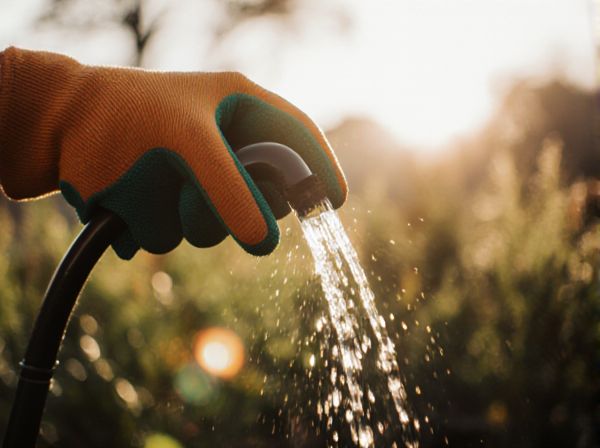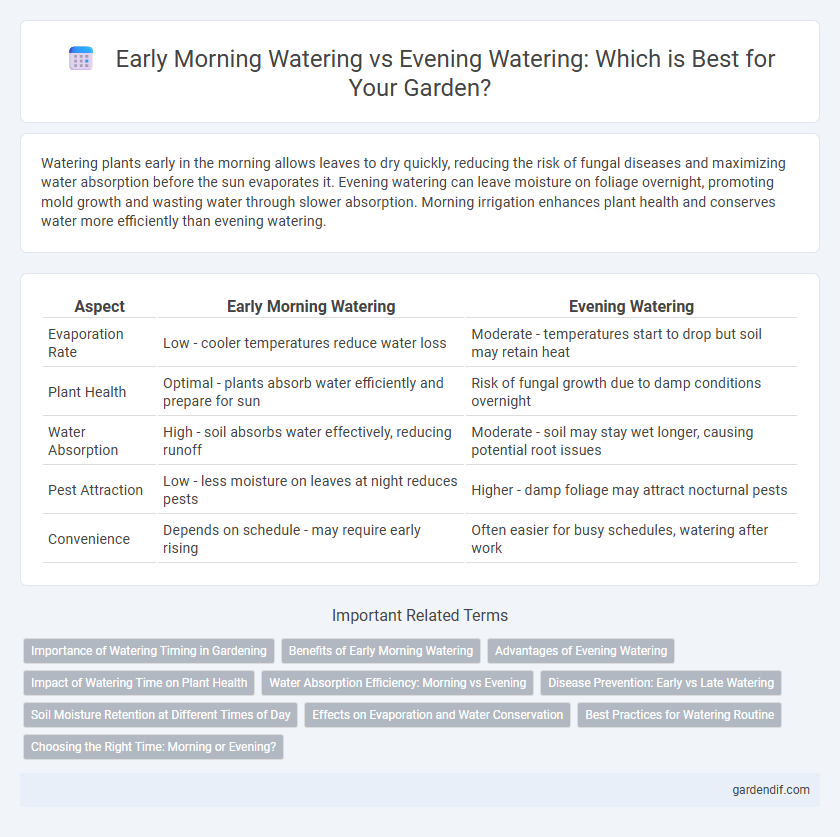
Early morning watering vs Evening watering Illustration
Watering plants early in the morning allows leaves to dry quickly, reducing the risk of fungal diseases and maximizing water absorption before the sun evaporates it. Evening watering can leave moisture on foliage overnight, promoting mold growth and wasting water through slower absorption. Morning irrigation enhances plant health and conserves water more efficiently than evening watering.
Table of Comparison
| Aspect | Early Morning Watering | Evening Watering |
|---|---|---|
| Evaporation Rate | Low - cooler temperatures reduce water loss | Moderate - temperatures start to drop but soil may retain heat |
| Plant Health | Optimal - plants absorb water efficiently and prepare for sun | Risk of fungal growth due to damp conditions overnight |
| Water Absorption | High - soil absorbs water effectively, reducing runoff | Moderate - soil may stay wet longer, causing potential root issues |
| Pest Attraction | Low - less moisture on leaves at night reduces pests | Higher - damp foliage may attract nocturnal pests |
| Convenience | Depends on schedule - may require early rising | Often easier for busy schedules, watering after work |
Importance of Watering Timing in Gardening
Watering plants during early morning hours maximizes water absorption by cooler soil and reduces evaporation rates, promoting healthier root growth. Evening watering can lead to prolonged leaf wetness, increasing the risk of fungal diseases and plant stress. Optimizing watering timing ensures efficient water use, enhances plant health, and minimizes water loss in gardening practices.
Benefits of Early Morning Watering
Early morning watering maximizes water absorption by plants due to cooler temperatures and reduced evaporation rates, ensuring deeper soil penetration. It strengthens root development and reduces the risk of fungal diseases that thrive in damp, cool conditions often present during evening watering. Morning moisture supports photosynthesis throughout the day, promoting healthier and more resilient plant growth.
Advantages of Evening Watering
Evening watering reduces water evaporation due to lower temperatures and calmer winds, allowing deeper soil absorption essential for healthy root growth. It minimizes plant stress by providing hydration during cooler hours, supporting sustained moisture retention overnight. This method also helps prevent fungal diseases that thrive in damp conditions when watering is done too late in the evening.
Impact of Watering Time on Plant Health
Watering plants early in the morning promotes optimal absorption and reduces evaporation loss, enhancing hydration and nutrient uptake. Evening watering can lead to prolonged leaf wetness, increasing the risk of fungal diseases and root rot. Selecting watering times based on plant species and local climate improves overall plant health and growth efficiency.
Water Absorption Efficiency: Morning vs Evening
Watering in the early morning maximizes water absorption efficiency by allowing plants to take up moisture before the heat of the day increases evaporation rates. Evening watering often leads to slower water absorption due to cooler temperatures and higher humidity, which can leave water on leaves longer, potentially causing fungal growth. Optimizing watering schedules for early morning ensures better hydration and healthier plant growth.
Disease Prevention: Early vs Late Watering
Watering plants early in the morning allows foliage to dry quickly, reducing the risk of fungal diseases such as powdery mildew and root rot. Evening watering leaves moisture on leaves overnight, creating a damp environment ideal for pathogens to thrive and increasing the likelihood of disease. Morning irrigation enhances plant health by minimizing prolonged leaf wetness, which is critical for effective disease prevention.
Soil Moisture Retention at Different Times of Day
Watering early in the morning maximizes soil moisture retention due to lower temperatures and reduced evaporation rates, allowing plants to absorb water efficiently throughout the day. In contrast, evening watering often leads to prolonged soil moisture but increases the risk of fungal diseases from extended dampness overnight. Optimizing watering times based on diurnal temperature variations enhances plant hydration while minimizing water loss and disease vulnerability.
Effects on Evaporation and Water Conservation
Early morning watering reduces evaporation by taking advantage of cooler temperatures and lower wind speeds, allowing more water to penetrate the soil. Evening watering risks increased water loss through evaporation and fosters conditions conducive to fungal growth due to prolonged moisture on plant surfaces. Efficient water conservation is achieved by scheduling irrigation during early hours to maximize absorption and minimize waste.
Best Practices for Watering Routine
Watering early in the morning reduces evaporation and allows plants to absorb moisture before the day heats up, promoting healthier root growth. Evening watering can lead to prolonged leaf wetness, increasing the risk of fungal diseases and mold development. Optimizing a watering routine involves scheduling irrigation during the cooler, less windy hours of early morning to maximize water efficiency and plant health.
Choosing the Right Time: Morning or Evening?
Watering plants early in the morning maximizes absorption as cooler temperatures reduce evaporation, ensuring roots receive sufficient moisture for optimal growth. Evening watering, while convenient, risks increased fungal growth due to prolonged leaf wetness overnight. Selecting morning watering enhances plant health by leveraging natural sunlight to dry leaves and supports efficient water use.
Early morning watering vs Evening watering Infographic

 gardendif.com
gardendif.com